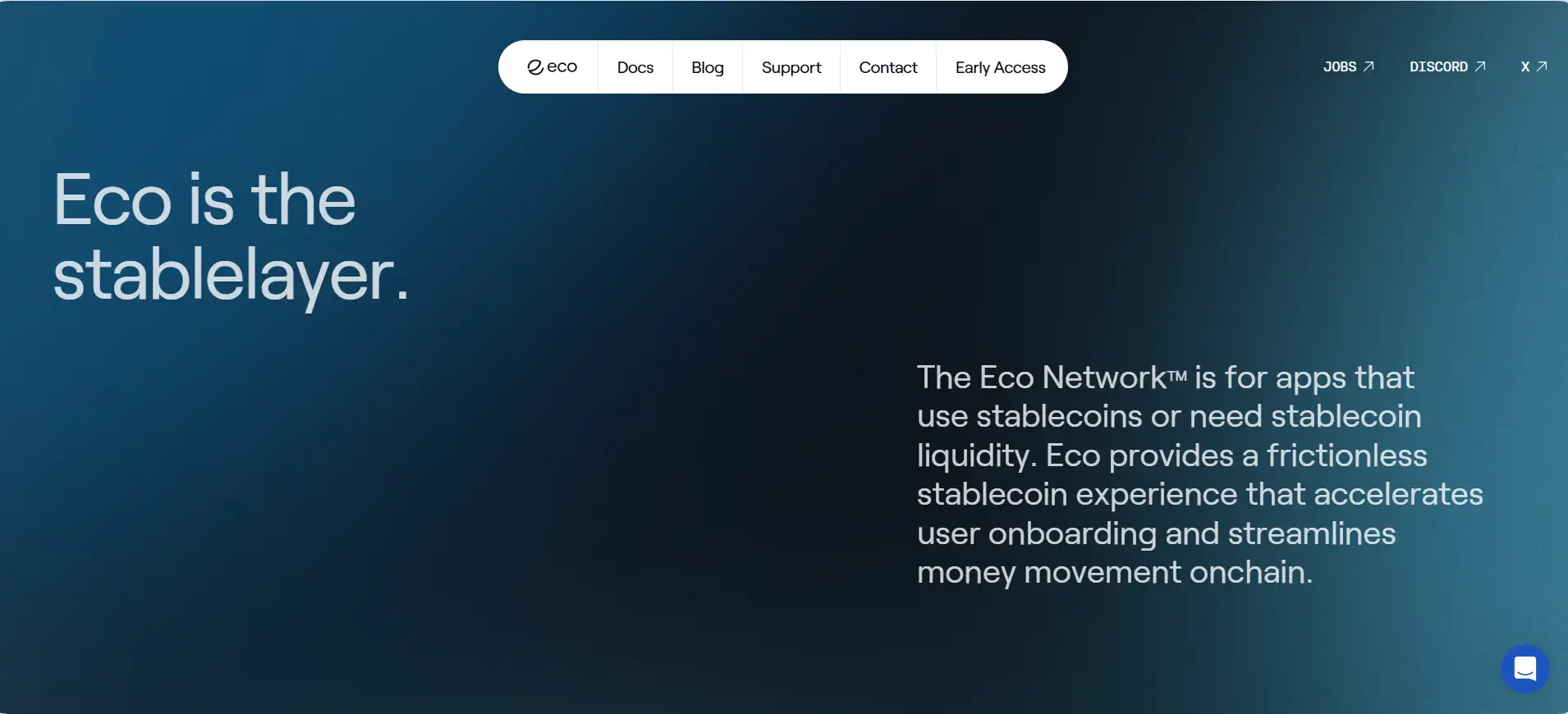About Eco
Eco is an innovative protocol that serves as a foundational stablecoin liquidity layer for onchain apps and blockchains. Built to resolve the inefficiencies of fragmented cross-chain finance, Eco simplifies how developers and users access, manage, and utilize stablecoins across decentralized applications. By abstracting away blockchain complexities, Eco provides a smooth and scalable infrastructure for secure stablecoin transfers, intuitive UX, and cross-chain account management.
The Eco Network is composed of three core components: Eco Routes, Eco Accounts, and Crowd Liquidity. Together, these products form a unified ecosystem that delivers frictionless stablecoin transfers, enables one-click UX across connected chains, and unlocks idle liquidity for yield generation. Eco’s mission is to make onchain money movement as accessible and usable as traditional finance—but with the power, speed, and openness of blockchain.
Eco addresses a core challenge in blockchain interoperability: the complexity and inefficiency of using stablecoins across different chains. Traditionally, stablecoin holders had to deal with bridges, high gas fees, and clunky interfaces—making user onboarding and retention difficult for apps. Eco changes this dynamic by creating a seamless, intent-based architecture for stablecoin liquidity and execution.
The protocol is built around three modular products. First is Eco Routes, a cross-chain stablecoin infrastructure that leverages “solvers” to handle capital-intensive execution and ensure stablecoin transfers happen securely and cheaply across Ethereum L2s and L3s. These solvers route liquidity on behalf of users, solving for their intents—what they want done—rather than requiring them to manage every transaction detail.
Next is Eco Accounts, a chain-abstracted SDK that allows users to maintain one stablecoin balance across multiple wallets and chains. With this, developers can deliver “one click” experiences, bundling complex actions like bridging, swapping, and sending into a single action. Accounts allow users to aggregate stablecoin spending power across all linked wallets, simplifying and accelerating how crypto is used.
Finally, Crowd Liquidity democratizes access to solver yield. By pooling idle stablecoins from Eco-connected wallets and protocols, the network increases its capacity to execute cross-chain intents instantly and at low cost. Anyone holding stablecoins on supported chains can opt in to earn passive yield while helping scale the ecosystem. It’s a sustainable, community-powered alternative to traditional liquidity mining.
Eco’s competitors include Across for cross-chain bridging, Connext for intents, and LayerZero for omnichain messaging. What sets Eco apart is its full-stack approach—combining account abstraction, solver-driven liquidity, and simple UX into a single, developer-friendly integration.
Eco provides numerous benefits and features that distinguish it in the cross-chain stablecoin infrastructure space:
- One-Click UX: Eco enables stablecoin-native applications with seamless “one click send” functionality across chains.
- Intent-Based Architecture: Eco Routes interpret user goals, not instructions, allowing solvers to fulfill the task without user micromanagement.
- Universal Liquidity Access: Eco aggregates stablecoin liquidity from all connected chains and protocols, unlocking maximum capital efficiency.
- Crowd-Sourced Yield: Users can earn yield on idle stablecoins through Crowd Liquidity while improving network performance.
- Developer-Ready SDKs: The Routes and Accounts SDKs make integration simple, enabling apps to plug into Eco with minimal friction.
- Security by Design: Features like storage proofs, resource locks, and message bridges reduce risk in cross-chain execution.
Eco makes it easy for developers and users to get started with cross-chain stablecoin liquidity:
- Visit the Website: Head to the Eco homepage to understand their product offerings and vision.
- Access Routes Portal: Try out Eco Routes in the Portal to see how seamless stablecoin transfers can be.
- Integrate the SDK: Developers can integrate the Routes SDK for cross-chain stablecoin execution and get early access to the Accounts SDK (launching March 2025).
- Join the Community: Connect with other users and builders on the official Discord and follow announcements via X (formerly Twitter).
- Get Early Access: Sign up on the Eco site to be notified when new features like Crowd Liquidity go live.
- Read the Docs: Explore full technical documentation via the “Docs” link on the Eco homepage.
Eco FAQ
Eco removes blockchain friction by introducing a seamless, “one-click” user experience for sending stablecoins across chains. Instead of manually managing swaps, bridges, and gas fees, users express an intent (e.g., “send $100 to X on Arbitrum”), and the system’s solvers take care of the execution. This model is similar to how apps like Uber or Venmo work—users request outcomes, not processes. By integrating Eco Routes and Accounts, developers can deliver this simplified UX within any app. Learn more on Eco’s official website.
Eco Accounts are not wallets themselves—they’re an SDK that aggregates balances across multiple wallets and chains to create a unified, abstracted user account. This enables users to act across ecosystems without needing to bridge or manually manage funds. Unlike a traditional wallet, Eco Accounts are built for cross-chain interoperability, using smart contract accounts and account abstraction features like transaction batching, flexible key management, and gas abstraction. For developers, it's like plugging in a better wallet layer without replacing the user's existing one. More info at eco.com.
Eco Crowd Liquidity enables users to put their idle stablecoins to work by pooling them into a solver network that executes onchain intents. This means your funds can be used to solve others' transfers—and you earn yield in the process. For the network, this pooled liquidity increases throughput, decreases latency, and boosts settlement reliability. It’s a win-win: users earn passive yield, and the network becomes faster and more efficient. Click here to learn how developers and DAOs can integrate it.
While Eco initially focuses on Ethereum L2s and L3s, its architecture is designed to support other ecosystems as well. Eco Routes are chain-agnostic, and the team is expanding support to non-EVM chains and other smart contract platforms. Any chain that can be connected through message bridges or intent verification can potentially integrate Eco infrastructure. The long-term vision is to create a universal stablecoin liquidity layer for all of Web3. Keep an eye on the roadmap at eco.com.
Eco uses multiple layers of protection to secure its cross-chain intent execution. This includes storage proofs for validating state across chains, message bridges for data transport, and resource locks that prevent double-spending by locking assets in the user's account until completion. Additionally, the protocol’s use of solvers creates a trust-minimized environment where liquidity is fronted by third parties, not held in vulnerable escrow contracts. This architecture greatly reduces capital loss risk. See the full technical details on the official site.
You Might Also Like












